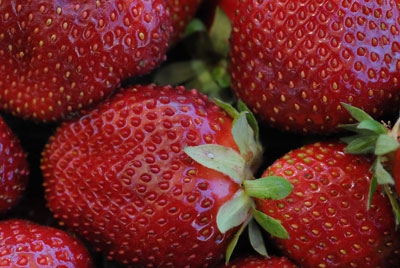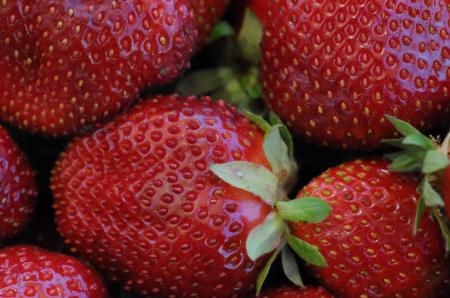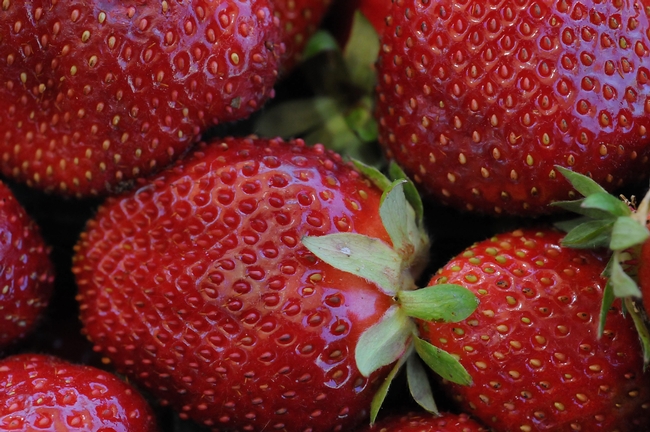Posts Tagged: Strawberries
Central Coast community celebrates strawberries
Arroyo Grande recently hosted its annual Strawberry Festival, said an article in the Santa Maria Times. And this year, the city has more than ever to celebrate. In 2011, strawberries took the top spot in terms of production value in the San Luis Obispo Agriculture Commissoner's crop report.
The county’s strawberries were valued at more than $179 million in 2011.
Surendra Dara, UC Cooperative Extension advisor in San Luis Obispo County, a strawberry expert, said the 2012 crop is still larger and doing very well.
“In the fields I’ve been checking, they’re very tasty,” Dara said.
The factor that has the greatest impact on strawberry sweetness and flavor, he said, is variety. The most popular variety is the Albion, which was developed by the University of California. The UC-developed San Andreas variety is also popular.
Chandler strawberries get attention
UC strawberry varieties — Chandler in particular — was the topic of a Los Angeles Times article by David Karp.
According to the article, Chandler was introduced in 1983 and was dominant in Southern California production in the late '80s and early '90s, before being surpassed by other varieties. Chandler was bred by Victor Voth and Royce Bringhurst of the University of California.
This year, a well-known strawberry grower among Southern California farmers markets has resumed growing the Chandler variety. Harry's Berries otherwise grows Gaviota and Seascape varieties, both also developed by the UC strawberry breeding program, but will be bringing Chandler berries to markets this year.
4-H Million Trees Project shelters Pacifica Gardens with natives and fruit trees
The Pacifica Tribune
4-H volunteers continue to plant trees for the 4-H Million Trees program, which was started in Pacifica by 4-H member Laura Webber. Reporter Jane Northrop covered 4-H volunteers planting hedge trees at Pacifica Gardens recently.
So far, the paper reports, the program has seen at least 41,000 children plant 350,000 trees.
The program has spurred many 4-H members to propose tree-planting projects at nearby schools, parks and neighborhoods. One of the teens who wrote a grant proposal for another tree-planting event explained why she took on the project.
"I basically wanted to write the grant because I thought it would be a great experience for me and I wanted to help in more ways than just showing up to the plantings. I also wanted to really push myself to do something that I had never done before," said Julia Hurley, a Pacifica 4-H member and eighth-grader.
Fresno farm meeting attracts Asian growers
Fresno Bee
Reporter Robert Rodriguez covered a meeting of Southeast Asian farmers in Fresno, where one of the primary topics was government regulations.
Richard Molinar, UC Cooperative Extension advisor in Fresno, has helped Southeast Asian farmers comply with regulations. At the meeting, he urged farmers to spread the word about how to follow government regulations and who can help.
"Part of this is your responsibility to find out what you need to do," he said. "This not an insurmountable problem."
The meeting was presented by the National Hmong American Farmers, and USDA's Joe Leonard, Jr., was the keynote speaker.
Ventura celebrates strawberries
Leading up to the California Strawberry Festival, to be held this weekend at Strawberry Meadows at College Park in Oxnard, the Ventura County Star championed the fruit's contribution to the local economy in an article published yesterday.
In 2009, strawberries contributed $515.4 million to the county's $1.6 billion of total agricultural revenues, the story said. That was up 31 percent from $393.5 million in 2008.
Ventura County agricultural commissioner Henry Gonzales said the next crop report will show growers added another 100 acres of strawberries in 2010.
"It's a good thing," Gonzales was quoted. "It says to me there's still room for growth in the production side because there's growth on the market side."
Reporter Stephanie Hoops contacted UC Cooperative Extension strawberry advisor Oleg Daugovish to get his take on the current strawberry season.
The article said Daugovish described the season as "decent."
Meanwhile, strawberry growers are feeling pressure from a controversy over a new soil fumigant, methyl iodide, which the Department of Pesticide Regulation approved in December.
"Concern about the ability to use it is great," Daugovish was quoted.
In March, Gov. Brown said he plans to take "a fresh look" at the DPR decision. Environmental and farmworker groups are opposed to methyl iodide use in agriculture, but DPR approved the pesticide's use under strict safety measures, including buffer zones and site-specific permits from local agricultural commissioners.

Strawberries make a significant contribution to the Ventura County economy.
Methyl bromide ban creates a 'new world' for strawberry growers
Strawberries are considered the jewels of Monterey County, but their production numbers will probably drop with the phase-out of methyl bromide, a highly effective soil fumigant that depletes the ozone layer, according to an article in the Salinas Californian.
"It's a new world for strawberries," the story quoted Mark Bolda, farm advisor for strawberries and caneberries for UCCE in Monterey, Santa Cruz and San Benito counties. After the phase out, "yields will go down and production will fall, but it's not Armageddon."
Bolda told the reporter that scientists have been searching for chemical alternatives to methyl bromide for about 20 years, but progress is slow because it's hard to top the effectiveness of methyl bromide mixed with chloropicrin.
One alternative to methyl bromide is methyl iodide. It does not damage the ozone layer, but has other drawbacks, including its cost, severe restrictions on its use, and a safety risk to workers or the public if they are exposed to the chemical.
The California Department of Pesticide Regulation approved the use of methyl iodide in early December.
According to an op-ed by Barry Bedwell of the Grape and Tree Fruit League that was published in the Bakersfield Californian Wednesday, growers can safely use methyl iodide.
"The reality is that California's restrictions on methyl iodide are many times greater than those required by U.S. EPA or any other jurisdiction," Bedwell wrote. "The use restrictions include large buffer zones, the requirement of only DPR-approved highly retentive tarps, specific groundwater protections, reduced application rates and stronger worker-protection measures."
Bedwell believes growers must have access to crop-production tools based upon rational and reasonable science in order to continue production in the state.
"If we allow the process to become a prisoner of emotion, we will not only find ourselves without methyl iodide but in the not-too-distant future the majority of our food production will come from places with much less regulatory oversight," Bedwell wrote.

Strawberry production will drop under methyl bromide phase-out.
Assemblyman encourages methyl iodide ban
Assemblyman Bill Monning, D-Carmel, urged his constituents to fight state approval of methyl iodide, a fumigant that is considered a viable alternative to methyl bromide, an ozone depleter now being phased out, according to an article in the Oakland Tribune.
Monning, chair of the Assembly Health Committee and currently running for reelection, participated in a forum about pesticides yesterday at Pajaro Middle School, in Pajaro (Monterey County).
"They use methyl iodide to cause cancer in lab animals," Monning was quoted by reporter Tovin Lapan. "It's not a question of whether, it's a question of when. There will be human damage, there will be environmental damage and there will be water damage."
The article also contained information from UC Cooperative Extension sources. Farm advisor Mark Bolda said 75 percent of the strawberry fields in the region are fumigated in some way. In Monterey and Santa Cruz counties, methyl bromide is the No. 1 pesticide used in all agricultural production.
On average, Bolda said, organic strawberry fields yield about 50 percent less than fumigated fields. "There are some organic plots with great yields, and some with very low yields," Bolda was quoted. "You always run the risk of being completely wiped out by disease with organic growing." UC Davis strawberry researcher Doug Shaw said that, in his studies on small plots, the crops fumigated with methyl iodide yielded 8 to 10 percent less than the methyl bromide-fumigated crop. The U.S. Environmental Protection Agency has approved methyl iodide for agricultural use and most states follow the U.S. EPA's lead. California, Washington, New York and Florida, however, have separate approval processes for pesticides. New York and Washington already have banned methyl iodide; Florida permits its use on high-value crops. Bolda believes the California Department of Pesticide Regulation's eventual decision on the pesticide may influence other states' use of methyl iodide. As goes California, the No. 1 consumer of pesticides in the United States, so goes the United States, Bolda said.

Conventional strawberry production involves the use of a soil fumigant before the crop is planted.


